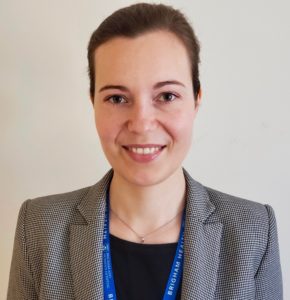 Katarzyna “Kasia” Klonowska, PhD, is a 2020 recipient of the TSC Alliance® Postdoctoral Fellowship Award. Kasia is a post-doctoral fellow in the laboratory of David Kwiatkowski, MD, PhD at Brigham and Women’s Hospital. Postdoctoral Fellowship awards are intended to provide funding for an individual who has recently earned a PhD or MD degree and support any type of basic or translational research relevant to tuberous sclerosis complex (TSC) that provides an outstanding opportunity for the trainee’s professional growth.
Katarzyna “Kasia” Klonowska, PhD, is a 2020 recipient of the TSC Alliance® Postdoctoral Fellowship Award. Kasia is a post-doctoral fellow in the laboratory of David Kwiatkowski, MD, PhD at Brigham and Women’s Hospital. Postdoctoral Fellowship awards are intended to provide funding for an individual who has recently earned a PhD or MD degree and support any type of basic or translational research relevant to tuberous sclerosis complex (TSC) that provides an outstanding opportunity for the trainee’s professional growth.
Kasia’s fellowship project, titled “Polyclonal somatic mutations drive TSC tumorigenesis,” uses cutting-edge genetic techniques to better understand TSC mosaicism and the TSC2 gene.
We recently talked with Kasia to learn more about her and her research.
What did you want to be when you grew up?
I have always liked learning biology and foreign languages. I was lucky to have a chance to combine both passions and become a scientist in the field of biology, working in a diverse international environment.
What activities do you do outside of the lab?
Outside of the lab, I enjoy spending time with my husband on outdoor activities, including bike trips to local reservations and parks around Boston. I also enjoy our unique lab tradition – joint hikes in White Mountains in New Hampshire organized by our mentor, Dr. David Kwiatkowski. Every trip to NH is an exceptional bonding experience!
Dr. Kwiatkowski lab group in White Mountains – Mount Pierce, 9-19-2021
How did you decide to become a scientist?
I made my first step toward science in high school, when I decided to continue my education in college in the major of Biotechnology. I think however that I started to be drawn to science when working on my master’s thesis project with my mentor, Dr. Piotr Kozlowski in the Institute of Bioorganic Chemistry of Polish Academy of Sciences in Poznan, Poland. It was the first time I had a chance to be responsible for the execution of a real scientific project, in a fascinating and important subject – genetic predisposition to breast cancer. This subject is especially interesting to study in the Polish population, known to carry founder mutations in several genes related to breast cancer predisposition. At this time, I realized that molecular genetics is the field that I want to study in depth as a scientist, continuing research in cancer genetics throughout my PhD with Dr. Kozlowski.
How did you become interested in TSC research?
I got familiar with TSC genetics when reading Dr. Kozlowski’s publications, summarizing research that he pursued during his postdoctoral fellowship in Boston, with Dr. Kwiatkowski, who is a leading expert in the genetics of TSC and its related tumors and manifestations. During my PhD program, I started a remote collaboration with Dr. Kwiatkowski, working on the analysis of large deletions in TSC1/TSC2 genes which inactivation leads to the development of TSC. I found TSC genetics extremely interesting to explore, especially having an opportunity to work on a variety of TSC-related samples from various tumors and matched normal samples from individuals with TSC, available in the repository in Dr. Kwiatkowski’s lab. I was also impressed by the study of Tyburczy et al., Plos Genetics, 2015, focused on detailed characterization of mutations (mostly mosaic) in patients who had no mutation identified (NMI) by prior genetic testing in clinical labs. Since March 2018, I have been doing a postdoctoral fellowship under the mentorship of Dr. Kwiatkowski at Brigham and Women’s Hospital/Harvard Medical School in Boston.
What do you study in the lab?
In the Kwiatkowski lab, I am involved in several research projects aimed at improving our understanding of genetic pathomechanisms of TSC and LAM. We are utilizing state-of-the-art genomic technologies to explore the somatic mutational landscape in TSC-related tumors. In 2020, I was awarded a TSC Alliance postdoctoral fellowship, which enabled us to pursue research studies focused on TSC genetics. Within the TSC Alliance fellowship, we developed a new next generation sequencing (NGS) strategy for TSC2 genetic changes detection, which is 10-fold more sensitive than previous methods for characterization of mosaicism in TSC. With our new method, we discovered that sunlight UV-related TSC2 genetic changes in facial skin is a pervasive phenomenon, likely generating thousands of incipient angiofibromas in the average TSC patient, small proportion of which develop into observable tumors. We are also using our ultrasensitive method for analysis of mutations in other TSC-related tumors, including a representative set of brain lesions, collected in the TSC Biosample Repository. We also used our new strategy to analyze low-level mosaicism in TSC and mutation identification for TSC patients for whom previous genetic testing was negative. The goal of our mosaicism studies is to better understand the clinical spectrum of mosaicism in TSC while enabling patients to make informed decisions about family planning with knowledge of the risk of disease transmission.
What is a topic in science that you are excited about?
I am excited about the huge progress that has been made in recent years in the field of genetics and genomics, and all the opportunities that we have for more precise and patient-tailored molecular analyses. I am privileged to be a member of research group which is taking advantage of these recent advances to apply various genomic strategies, including multi-omics and single cell sequencing, to better understand TSC pathogenesis and eventually find new therapies for TSC.
Kasia was lead author on the recent research article, “Sporadic facial angiofibroma and sporadic angiomyolipoma mimicking tuberous sclerosis complex,” published in the Journal of Medical Genetics on October 11, 2021.

